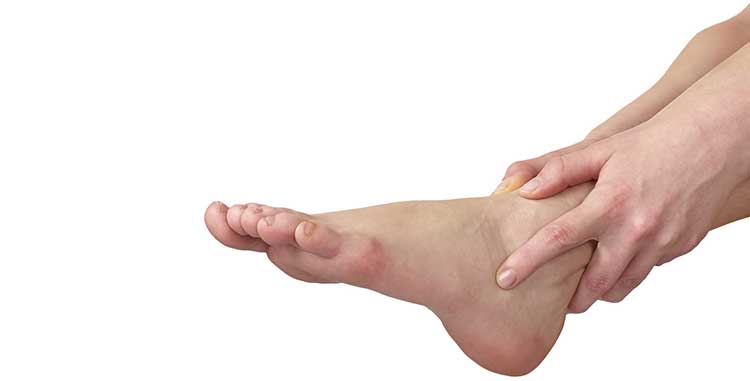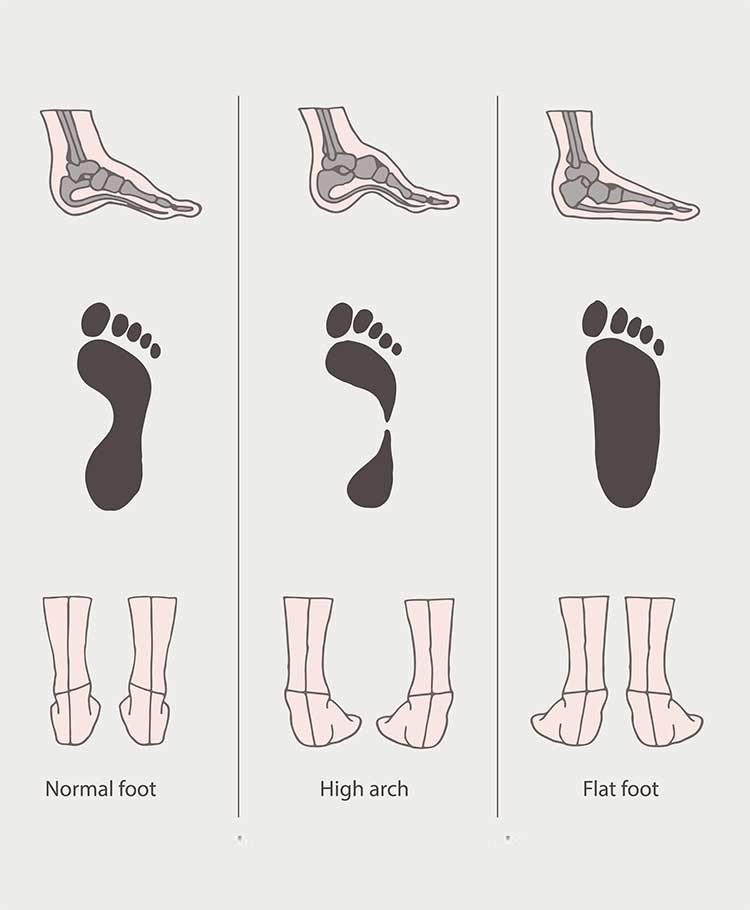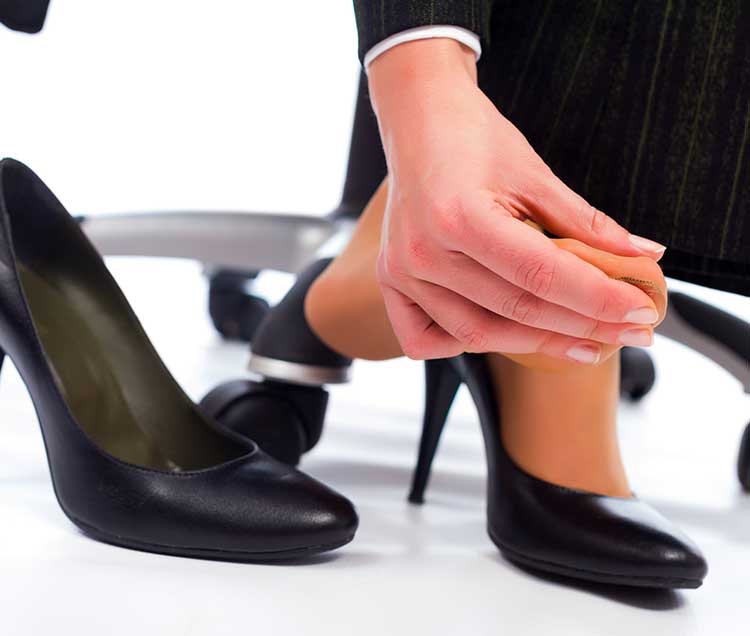
Find relief from foot and ankle pain today.
Orthopedic issues that affect the feet and ankles can be especially challenging and painful, often making it difficult to walk, exercise, and work. Contacting our office for your foot and ankle pain ensures that you will be back to your regular activities sooner, and with the help of minimally invasive procedures.
- Your doctor can help determine which non-surgical treatment method should be used.
- If necessary, your doctor will let you know which surgical procedure can be used to help
Sprains – Ankle sprains are common and can happen to anyone. They occur when your foot rolls or twists in a way that isn’t normal, like if you step hard on an uneven surface. There are different grades or severities of sprains. A minor sprain involves stretching your ligament beyond its limits, but a severe sprain can cause tearing of the ligament’s fibers. Pain, swelling, and tenderness can occur. Treatment can involve resting your foot, icing it, using compression socks, and in extreme causes, surgery that repairs the torn ligament. Your doctor can also tell you which exercises are most helpful for regaining movement, and when you should pick up your regular activities.
Achilles tendonitis – This condition causes pain and stiffness near the heel, where your Achilles tendon is located. This tendon is responsible for helping you to walk and run, so it’s not unusual for it to develop tendonitis (or inflammation) as a result of overuse or repetitive movement. Early treatment is important for reducing pain effectively, and can involve rest, ice, anti-inflammatory medication or injections, physical therapy, custom foot orthotics, and more.
Plantar fasciitis – The most common cause of pain at the bottom of the heel, plantar fasciitis develops when the band of tissue supporting your foot’s arch becomes inflamed. The plantar fascia ligament connects the front of your foot to your heel and can become damaged over time. If you have plantar fasciitis, you might notice that the pain is worse when you get up in the morning or when you finish exercise or other physical activity. Effective treatments can include rest, ice, anti-inflammatory medication, stretches, night splints, custom orthotics, and more.


Flat feet – Also known as flat arches, this condition can present from birth (if your arches never form) or can develop following an injury. Flat feet typically do not cause any pain, but if they do, the pain will be in the heel or arch area. Swelling can also occur. Custom orthotics, arch supports, and other orthopedic treatment approaches can help to reduce pain and swelling. Surgery for flat feet is rare, but can be performed to reconstruct the foot.
High arches – Also known as pes cavus or cavus foot, high arches in the foot are typically caused by a neurological disorder, like cerebral palsy. A high arch causes extra weight to be placed onto the heel, which can lead to a lot of pain and instability. Other symptoms that can be present with high arches include calluses and hammer toes. Treatments for high arches can include bracing, orthotics, and shoe modifications for stability.
Chronic ankle instability – This condition usually presents itself following a sprained ankle that did not heal properly. It results in the ankle consistently turning on even surfaces or while participating in sports, and is often accompanied by pain and tenderness. Medications, bracing, and physical therapy can help chronic ankle instability. Surgery might be necessary to repair damaged ligaments.
Foot arthritis – Arthritis is pain and inflammation of the joint, and it can be caused by general aging and wear and tear or an injury. This can result in pain, stiffness, and swelling. Foot arthritis can be managed with medications, steroid injections, physical therapy, bracing, and orthotic devices. In some cases, surgery is needed to improve function.
Athlete’s foot – An infection caused by fungus, athlete’s foot can result in scaling skin, dryness, itch, blisters, cracks, and inflammation. Specialized creams, sprays, and anti-fungal powders are used to treat athlete’s foot.
Bunions – A bunion is characterized by a bony bump on the side of the foot, near the big toe. Bunions are caused by improper foot mechanics – those that are inherited or caused by wearing tight shoes. The condition can cause pain, discomfort, inflammation, burning, and numbness. Medications, padding, and orthotic devices are among the non-surgical approaches that can manage pain associated with bunions. Surgery to remove the bump can also be performed.
Peripheral neuropathy – This condition is characterized by nerve damage caused by diabetes. It can result in tingling, numbness, and pain in the feet and legs. Depending on the nerves that are affected, it can also cause loss of balance and muscle weakness. Blood sugar control is an important part of treating peripheral neuropathy, and your orthopedic doctor can help you to treat complications.
Gout – This condition is caused by the buildup of uric acid in joints or tissues, and commonly affects the big toe. Gout is often inherited but can also accompany diabetes, obesity, and stress. Gout attacks come on suddenly, often in the middle of the night, and consist of intense pain. Treatments for gout include drinking lots of fluids, taking certain medications, and restricting certain foods.
Hammertoes – This condition is caused by a muscle and tendon imbalance and can be aggravated by improperly fitted shoes. It can result in pain, inflammation, redness, and corns and calluses. You may be able to manage the condition with custom orthotics, medications, splinting, and changing your shoewear. Surgery can be used if the hammertoe has become extremely rigid.
Morton’s neuroma – A Morton’s neuroma is the thickening of nerve tissue in the foot. It can be caused by anything that causes compression of the nerve, such as wearing tight shoes or running. Symptoms include pain, tingling, and a feeling that you are stepping on a stone. Mild to moderate Morton’s neuromas can be managed with orthotics, padding, icing, medications, and shoe modifications. Surgery might be necessary for more extreme cases.
Stress fracture – A stress fracture is a tiny break in the foot—about the width of a hair. Causes include overuse, improper shoes, injuries, and foot deformities. Symptoms of a stress fracture include bruising, pain, redness, and swelling. These fractures can lead to a full break without treatment, which can include rest and immobilization. Surgery can sometimes be necessary to stabilize the fracture.
Tarsal coalition – A tarsal coalition is characterized by an abnormal connection (consisting of cartilage, bone, or fibrous tissue) between the tarsal bones in the foot. This is typically caused by abnormal development before birth, but infection and injury can also cause tarsal coalition. The condition causes pain, fatigued legs, stiffness, and limited motion. Treatments are used to restore motion and relieve pain and can include steroid injections, orthotics, physical therapy, and medications. Surgery may be used if the symptoms are not resolved with non-surgical methods.
Tarsal tunnel syndrome – Compression on the posterior of the nerve can cause tarsal tunnel syndrome, and symptoms include numbness, shooting pain, and tingling. Injection therapy, orthotics, bracing, physical therapy, immobilization, and oral medications may be used to treat the condition. Sometimes, surgery is needed.
Broken toes – You have 19 toe bones in your foot. Any direct impact, from a sports injury to simply stubbing your toe, can result in a fracture. If it hurts to touch the area or if you experience pain during physical activity, a broken toe may be the cause. Swelling is also a symptom of a broken toe. Rest, splinting, taping, and immobilization are approaches to treatment.
Turf toe – Turf toe is a sprain of your big toe. This usually occurs after excessive upward bending of the toe during physical activity. In fact, the condition gets its name from the fact that it is mostly commonly seen in athletes. Symptoms of turf toe include pain, swelling, and limited movement. The R.I.C.E. method is used for treatment (rest, ice, compression, elevation) and surgery may be used for extreme cases.
Diabetic ulcers – Diabetic foot ulcers can develop as a result of peripheral neuropathy and mechanical changes in the foot. About 15% of diabetic patients experience diabetic ulcers. Loss of feeling in the foot, irritation, poor circulation, and trauma are all contributing factors to diabetic ulcers. Symptoms include drainage in your socks, swelling, and redness. Treatment methods include redistributing pressure, debridement, and medications. In some cases, surgery is performed to remove pressure from the area.
Metartarsalgia – This condition is the painful inflammation of the ball of your foot. It is most common in patients who wear shoes that are too small or do a lot of running or jumping. Symptoms include pain in the ball of your foot, tingling or numbness in your toes, pain that improves upon rest, and a feeling of something being in your shoe. Treatments used for metartarsalgia are rest, icing, shoe inserts, and arch supports.

